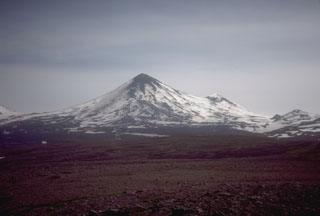Report on Pavlof (United States) — 15 August-21 August 2007
Smithsonian Institution / US Geological Survey
Weekly Volcanic Activity Report, 15 August-21 August 2007
Managing Editor: Sally Sennert.
Please cite this report as:
Global Volcanism Program, 2007. Report on Pavlof (United States) (Sennert, S, ed.). Weekly Volcanic Activity Report, 15 August-21 August 2007. Smithsonian Institution and US Geological Survey.
Pavlof
United States
55.417°N, 161.894°W; summit elev. 2493 m
All times are local (unless otherwise noted)
AVO raised the Volcanic Alert Level to Advisory and the Aviation Color Code to Yellow for Pavlof on 14 August due to an abrupt increase in seismicity. During 14-15 August, a strong thermal anomaly was detected in the crater and prompted AVO to again raise the Volcanic Alert Level/ Aviation Color Code, to Watch/Orange. According to eye witnesses aboard a ship on 15 August, incandescent blocks rolled down the ESE flank and lava-fountaining occurred on the SE flank. The presence of lava was confirmed using satellite imagery. Pilots reported that the flanks were covered with ash and that an ash plume rose to an altitude of 2.6 km (8,400 ft) a.s.l. and drifted SW.
On 16 August, residents of Cold Bay, about 60 km SW, and of Sand Point, about 97 km ESE, saw incandescence at the summit. A strong thermal anomaly was present at the summit on satellite imagery. Seismicity increased in intensity and possibly indicated a lahar on the SE flank.
During 17-20 August, seismicity continued at high levels. Explosions were recorded and seismic signals possibly indicated flow events such as lahars. A strong thermal anomaly continued to be present at the summit. Aerial and ground observations revealed a vigorous eruption of lava during 18-20 August. Members of an AVO field party saw a lahar on the SE flank on 20 August.
Geological Summary. The most active volcano of the Aleutian arc, Pavlof is a Holocene stratovolcano that was constructed along a line of vents extending NE from the Emmons Lake caldera. Pavlof and Pavlof Sister to the NE form a dramatic pair of symmetrical, glacier-covered stratovolcanoes that overlook Pavlof and Volcano bays. Little Pavlof is a smaller cone on the SW flank of Pavlof volcano, near the rim of Emmons Lake caldera. Unlike Pavlof Sister, eruptions have frequently been reported from Pavlof, typically Strombolian to Vulcanian explosive eruptions from the summit vents and occasional lava flows. The active vents lie near the summit on the north and east sides. The largest recorded eruption took place in 1911, at the end of a 5-year-long eruptive episode, when a fissure opened on the N flank, ejecting large blocks and issuing lava flows.
Source: US Geological Survey Alaska Volcano Observatory (AVO)

